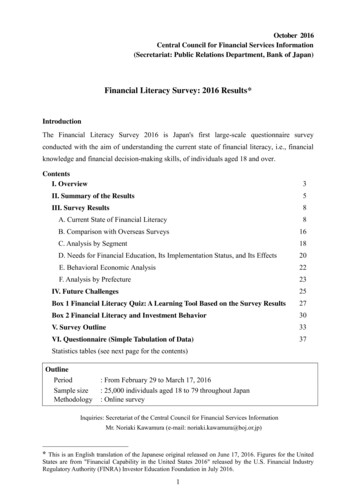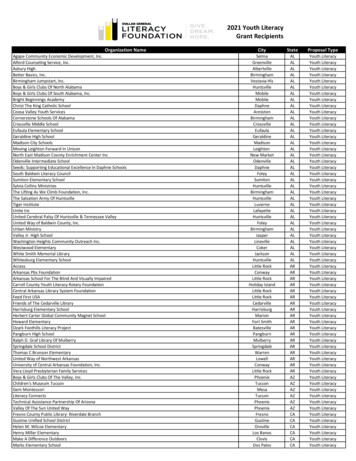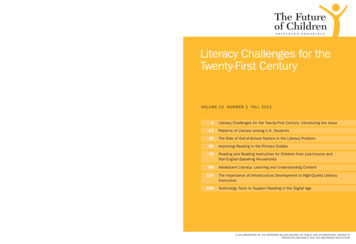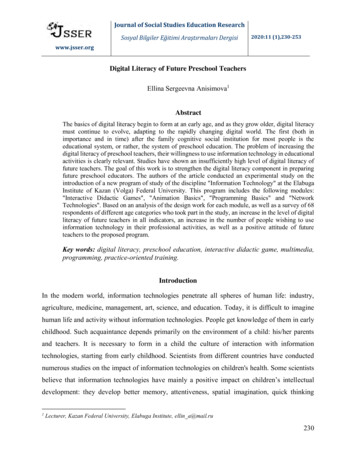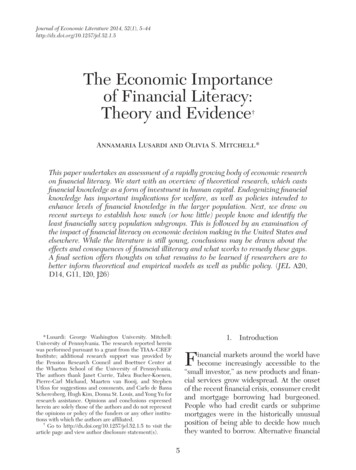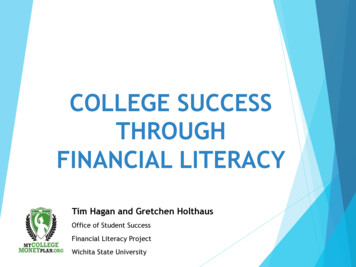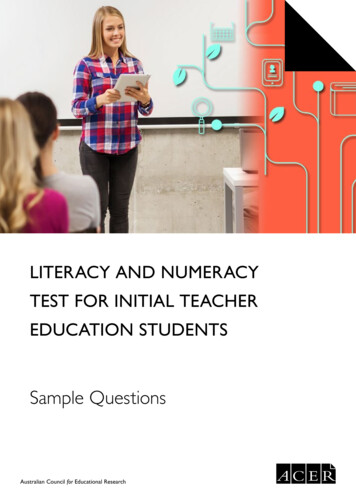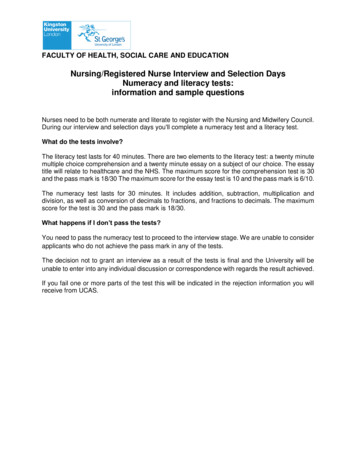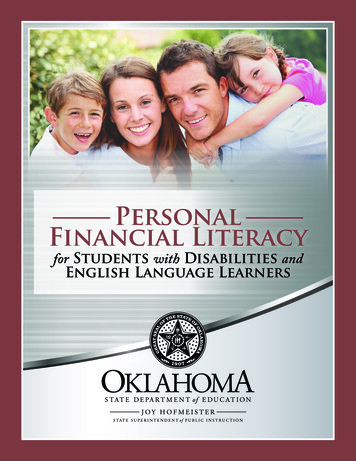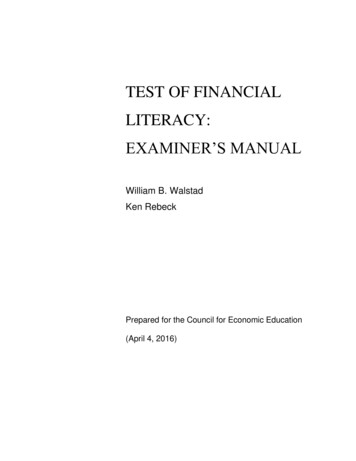
Transcription
TEST OF FINANCIALLITERACY:EXAMINER’S MANUALWilliam B. WalstadKen RebeckPrepared for the Council for Economic Education(April 4, 2016)
ABOUT THE AUTHORSWilliam B. Walstad is Professor of Economics at the University of Nebraska–Lincoln.Ken Rebeck is Professor of Economics at St. Cloud State University (Minnesota).Copyright 2016, Council for Economic Education. All rights reserved. No part of this book maybe reproduced in any form by any means without the prior written permission from the publisher.Printed in the United States of America.
TABLE OF CONTENTSPageFOREWORD. iiiEXAMINER’S MANUAL1. Test Development.12. The Content and Structure of the Test.43. Uses of the Test .94. Administering the Test .105. Technical Data .126. Item Rationale .207. References .29LIST OF TABLESTable 1. TFL Standards and Benchmarks.5Table 2. Aggregate Statistics for the Student Sample Taking the TFL .12Table 3. Percentiles for TFL Scores .13Table 4. Item Discrimination and Percentage of Correct Responses .14Table 5. Percentage Response to Each Alternative: full sample .15Table 6. Percentage Response to Each Alternative: with instruction .16Table 7. Percentage Response to Each Alternative: without instruction.16Table 8. Descriptive Statistics for TFL: Students with andwithout Personal Finance or Economics Instruction .19APPENDICESAppendix 1. Personnel for the TFL .30Appendix 2. Schools Participating in TFL testing .31Appendix 3. Answer Form and Scoring Key .33ii
FOREWORDThe Council for Economic Education (CEE) is deeply committed to providingthe highest quality instructional products for teachers to use in their classrooms togive their students the educational tools for understanding personal finance.Providing teachers with up-to-date assessments is part of the total package. TheTest of Financial Literacy: Examiner’s Manual offers teachers and test administrators the essential information they need in order to test the understanding of highschool students on personal finance and compare the results with other high schoolstudents across the nation.The Test of Financial Literacy is one of three CEE standardized assessmentsfor personal finance. The other two assessments are the Test of FinancialKnowledge for upper middle school or lower high school students (eighth and ninthgraders) and the Basic Finance Test for upper elementary school or lower middleschool students (fifth and sixth graders). All three assessments are available onlinefor teacher use with students. The CEE also has a test bank of questions for teachersto use to construct their own tests for diagnostic purposes. Information about thewebsite can be found at: sessment-center/The CEE is truly indebted to many individuals who shared their multitude oftalent and their precious time to write, review, and revise items for the Test of Financial Literacy that are based on the content specifications in the CEE’s NationalStandards for Financial Literacy (2013). Special thanks go to William Walstad fordirecting the project for the CEE and undertaking the test development work withhis associate director, Ken Rebeck. Members of the National Advisory Committee(acknowledged by name and institution on page 3 and in Appendix 1) also providedinvaluable assistance in preparing and revising test items to be used for the testdrafts.The CEE gratefully acknowledges the generous funding and support of PwCfor making this accomplishment possible.Council for Economic Educationiii
TEST OF FINANCIAL LITERACY: EXAMINER’S MANUALThe Test of Financial Literacy (TFL) is astandardized test for measuring the achievement ofhigh school students in units or courses that emphasize content and instruction in personal finance. The test should be a valuable tool for assessing what students know about the basics ofpersonal finance and related concepts in economics or business.The TFL Examiner’s Manual provides test users with the information they need to administerthe test and interpret the results. It has three majorobjectives. First, it gives test users a detailed description of the test content along with item rationales so they can understand how the test covers important content specified in national standards forpersonal finance. Second, it explains how the testshould be administered to students and discussesthe possible uses of the test for assessment and instruction. Third, it presents statistical evidence onthe reliability and validity of the test as a measureachievement in personal finance that would typically be taught at the high school level.The CEE secured funding from PwC in summer 2014 for the development of the three standardized tests in personal finance. The PwC supportfor the CEE also included funding for the development of an online assessment center to house allthe CEE standardized tests in both economics andpersonal finance. In addition, a test bank of questions from CEE publications in personal financeand economics would be added to the online assessment center so that teachers could create theirown classroom tests. This Examiner’s Manualonly describes the test development phase of theproject and primarily focuses on the TFL.Test Specifications. Several decisions weremade prior to or during test development that affected the content and features of the three new assessments. First, each test was designed to assessstudent understanding of the materials contained inthe FL Standards. The specific content for testquestions would be drawn from the benchmarksfor each standard, but sorted by grade level to construct the three new tests. The TFL content wouldemphasize what students should know by twelfthgrade as described in the 63 twelfth grade benchmarks. The middle school test, called the Test ofFinancial Knowledge (TFK), would assess the 49eighth grade benchmarks. The elementary test, titled the Basic Finance Test (BFT), would use the32 fourth grade benchmarks for test content.Second, the design of the three personal finance tests would be similar to the CEE’s threestandardized tests in economics. These tests wereprepared to assess standards and benchmarks in theCEE’s Voluntary National Content Standards inEconomics (CEE 2010). They include the highschool Test of Economic Literacy (TEL), the middle school Test of Economic Knowledge (TEK),and elementary school Basic Economics Test(BET). The new tests also would complement thehigh school, middle school, and elementary schoolassessment instruments for the CEE’s FinancialFitness for Life (FFFL) curriculum. The contentfor the new tests, however, would be based on FL1. TEST DEVELOPMENTIn 2013, the Council for Economic Education(CEE) published the National Standards for Financial Literacy (hereafter FL Standards). Thisdocument describes six major content areas forpersonal finance instruction in the nation’sschools: (1) earning an income; (2) buying goodsand services; (3) saving; (4) using credit; (5) financial investing; and, (6) protecting and insuring financial assets. Associated with these six standardsare 144 benchmarks that explain in more detailwhat students should know about the standards andhow to use this knowledge by the end of the fourth,eighth, and twelfth grades.At the time of publication of the FL Standards,no standardized tests were available to assess student understanding of these standards. The CEEtherefore sought funding for a project to createthree tests, one for use in high school, another formiddle school, and the third for elementary school.1TFL Examiner’s Manual 2016 Council for Economic Education (NY)
Standards and thus would not be tied to an assessment of any particular curricula.Third, for norming or test data purposes theTFL, TFK, and BFT would be administered tosamples of students at several grade levels to coverthe ranges for the major transition points in precollege education as was the case with the three standardized economics test (TEL, TEK, and BET).The TFL would assess student understanding at ornear the end of high school (eleventh and twelfthgrades). The TFK would be used for measuringstudent achievement at the end of middle school orthe beginning of high school (eighth and ninthgrades). The BFT would test students at the end ofelementary school or the beginning of middleschool (fifth and sixth grades).Fourth, a multiple-choice format would beused for each instrument so a test would sample awider range of the content domain as specified inthe benchmarks for the FL Standards. This decision was important because it permitted a sufficient number of test items to be distributed acrosseach of the six standards and the many benchmarksat each grade level. This format would make themost efficient use of the available resources for assessments, and it was consistent with the practiceadopted for the three standardized economics tests(TEL, TEK, and BET).Fifth, each test was to be an achievement testand not a speed test. The number of multiplechoice questions included on each one would belimited to what most students could reasonably beexpected to answer in about a 45-minute class period. This time period was well within the timelength of most classes and would allow ample opportunity for teachers to make arrangement withina classroom for giving test instructions and administering the test. Most questions on each instrument would not be overly complex so that mosttest items could be answered in less than a minute,on average. More time, however, would be allocated for completion of the elementary test because some elementary students may have moredifficulty with reading. Past experience with thethree standardized economics tests indicated thatmost students had sufficient time to answer the 45items on the TEL, the 40 items on the TEK, andthe 30 items on the BET. Accordingly, the acceptable ranges for the number of items on a testwere set at 45 to 50 items for the TFL, 40 to 45 forthe TFK, and 30 to 35 for the BFT.Personnel. William Walstad, Professor ofEconomics at the University of Nebraska-Lincolnand Editor of the Journal of Economic Education,was the director of the test project. His responsibility was to select the item writers, conduct meetings, develop test items, prepare the final tests,oversee statistical analysis, and write an examiner’s manual for each test. Ken Rebeck, Professorof Economics at St. Cloud State University, wasthe associate project director. His job was to workwith Walstad on the item development, preparation of the tests, conduct the statistical analysis,and co-author an examiner’s manual for each test.Both Walstad and Rebeck have extensive experience in the collaborative development of national tests in economics and personal finance.Their past work with personal finance assessmentsincluded preparation of three FFFL tests. Theyalso directed projects to prepare new editions ofthe TEL, TEK, and BET, and co-authored examiner’s manuals for each of those tests. In addition,they had conducted a research study on the effectiveness of a high school curriculum in personal finance (Financing Your Future) (Walstad, Rebeck,and MacDonald 2010). Walstad served on thewriting committee for the FL Standards. Rebeckhas made many presentations at teacher workshopson personal finance and economics through theMinnesota Council on Economic Education.The CEE representative for the project wasKevin Gotchet, a director of programs at the CEE.He previously worked on the CEE’s Excellence inEconomic Education project, which was funded bya multi-year grant from the U.S. Department ofEducation. Gotchet worked with Walstad on selection of the personnel for the project, managedthe budget, helped organize meetings, arranged fordata collection though the CEE’s online assessment center, and monitored progress of the projectfor the CEE.2TFL Examiner’s Manual 2016 Council for Economic Education (NY)
In summer 2014, Walstad and Gotchet createda National Advisory Committee (NAC) for the testproject that included five independent members,who together had expertise in classroom instruction in personal finance and economics, had conducted precollege teacher training in personal finance and economics, and were experienced intest-item writing. William Bosshardt, AssociateProfessor of Economics and Director of the Centerfor Economic Education at Florida Atlantic University, has many years of experience in providingtraining in economics and personal finance for precollege teachers. He also had served on test development committees for the TEL, TEK, and BETand was the project director in charge of writingthe CEE’s FL Standards. Elizabeth Breitbach isClinical Assistant Professor of Economics at theUniversity of South Carolina. Her research andpublications focus on the effect of financial literacy on banking participation. Brenda Cude is aprofessor in the Department of Financial Planning,Housing, and Consumer Economics at the University of Georgia. She teaches courses for undergraduates on personal finance and conducts research on the financial literacy of college students.Andrew Hill is an economic education advisor atthe Philadelphia Federal Reserve Bank. He also isa team leader for a teacher training program in thePhiladelphia area for a high school course in personal finance (Keys to Financial Success) and wasa writer for the FL Standards. Bonnie Meszaros,Associate Director at the Center for Economic Education and Entrepreneurship at the University ofDelaware, provides training in economics and personal finance to area teachers. She has served ontest development committees for the BET andTEK and was a writer for the FL Standards.in personal finance or non-CEE instructional material. Items from CEE or other source material,however, would only serve as an “example” thatcould be used for writing a new item on the samecontent. The project requirement for any item included on one of the tests was that the item be new.The different stages of review and editing of itemsthroughout test development would ensure that requirement was met for all test items.All of the 335 items submitted for review bythe NAC members and the two project directorswere coded by standard and benchmark using theCEE’s FL Standards. The coding permitted itemsto be sorted to identify content gaps where therewere no test items and where new ones needed tobe written. The pool of items also was rated usingfour categories: (1) accept as is; (2) requires minorrevision; (3) requires major revision; and (4) rejectand do not use. Most items received a 2 or 3 ratingfrom the NAC and project directors. The groupmade changes to items that could be easily revisedand left other items for revision after the meeting.Some new items also were written at the meeting.The final set of items selected for further revision were then assigned to the group members towork on at their home locations. For each standard, one committee member was assigned primaryresponsibility for revising items for that standardand filling content gaps with a few new items. Asecond committee member would then review therevised items from the first committee member andoffer further comments and changes. At the completion of the revision process, the revised itemsfrom all standards were compiled by the project director for further review.The second NAC meeting with the two projectdirectors was held in Dallas in October 2014. Theprimary purpose for this day-long meeting was toreview and revise all items in the question pool.Items that could be changed easily were revised bythe group at the meeting. Other items that requiredmore work were assigned to committee membersto change after the meeting and then be sent to theproject director and associate director for furtherreview.Item Writing. The first meeting of the NACwith the project directors was held for two days inmid-August, 2014 in Atlanta, Georgia. Each NACmember and the two directors were responsible forsupplying about 40–50 test items for review at themeeting. The items could be new or drawn fromvarious sources, such as CEE-published curricula3TFL Examiner’s Manual 2016 Council for Economic Education (NY)
In November, the revised questions from theDallas meeting and the follow-up work at homesites were compiled by the project director. Thetotal of 318 possible items included 53 for standard1, 38 for standard 2, 42 for standard 3, 69 for standard 4, 60 for standard 5, and 56 for standard 6. Theset of items were then rated by the NAC and theproject directors using the 1–4 rating scale previously described.The project director and associate director metin Sioux Falls, South Dakota, on January 16–17,2015, to prepare a draft of each of the three tests.For this drafting process, the 318 possible itemswere sorted by standard, and then by grade leveland benchmark within a standard. The project directors then selected what they thought were thebest items for each test based on the grade level ofitems, the quality of the items, the 1–4 ratings fromthe review process, and the distribution of test content across benchmarks. This work produced initial drafts of the TFL, TFK, and BFT.After the meeting, the project directors continued to refine each draft. Nine new items were written and added to the TFL to cover missing benchmarks or improve the content distribution acrossstandards. Ten new items were written and addedto the TFK and nine new items were written andadded to the BFT for similar reasons.Further refinements were then made to eachdraft. The length of the item options were orderedfrom shortest to longest, or if necessary from longest to shortest, to eliminate any clues to a correctanswer based on option length. To the extent possible, the correct answer was randomized acrossthe four options (A, B, C, or D) so that each onewas about equally likely to be the correct answer.The names for individuals in item stems and thefour options were split about equally betweenmales and females. Names also were updated touse the most popular ones as found in recent birthlists of names. Each item was carefully checkedfor correct grammar and spelling. Each test alsowas administered to three students for review, onefor each grade level, to get further feedback and tocheck on the appropriateness of items.In February 2015, a near-final draft of each testwas sent to members of the NAC for their last review and comment. The main request to the NACwas to make sure that there was only one best orcorrect answer to each test item. The review bythe NAC uncovered a few minor wording problems with questions that were corrected, but foundno problem with the correct answers.In late February 2015 each test was sent by theproject director to the CEE for entry into the CEEOnline Assessment Center. In February 2016 theaccumulated data from the online testing over ayear was used to identify five TFL and five TFKitems that appeared too hard or did not captureknowledge of the underlying benchmarks as wellas items on the rest of the tests. The final result ofthe revision work was a 45-item TFL covering 45of the 63 twelfth-grade benchmarks (71 percent ofbenchmarks), a 40-item TFK covering 39 of the 49eighth-grade benchmarks (80 percent of benchmarks), and a 35-item BFT covering all of the 32fourth-grade benchmarks (100 percent of benchmarks).The last section of this Examiner’s Manualpresents the 45 test items for the TFL and gives awritten rationale for the correct answer. As will bediscussed in the next section, there was good coverage of the personal finance concepts to establishthe content validity of the TFL. Short teacher andstudent surveys were included with the online version of the TFL to collect some background information that would be used for the analysis of thetest data. Other sections of this manual discuss results from the analysis of test validity and reliability.2. THE CONTENT AND STRUCTURE OFTHE TESTThe FL Standards provides a description ofwhat experts in personal finance and economicsconsider to be core content in personal finance thatshould be taught by the twelfth grade. Table 1shows the standards and the distribution of itemsacross the twelfth grade benchmarks for the TFL.4TFL Examiner’s Manual 2016 Council for Economic Education (NY)
TABLE 1. TFL Standards and BenchmarksStandard 1: Earning IncomePeople make choices to protect themselves from the financial risk of lost income, assets, health, or identity.They can choose to accept risk, reduce risk, or transfer the risk to others. Insurance allows people to transferrisk by paying a fee now to avoid the possibility of a larger loss later. The price of insurance is influenced byan individual’s behavior.Income Benchmarks: Grade 121. People choose jobs or careers for which they are qualified based on the income they expect to earn andthe benefits, such as health insurance coverage or a retirement plan, they expect to receive.2. People choose jobs or careers for which they are qualified based on non-income factors, such as job satisfaction, independence, risk, family, or location.3. People vary in their willingness to obtain more education or training because these decisions involve incurring immediate costs to obtain future benefits. Discounting the future benefits of education and training may lead some people to pass up potentially high rates of return that more education and trainingmay offer.4. People can make more informed education, job, or career decisions by evaluating the benefits and costsof different choices.5. The wage or salary paid to workers in jobs is usually determined by the labor market. Businesses aregenerally willing to pay more productive workers higher wages or salaries than less productive workers.6. Changes in economic conditions or the labor market can cause changes in a worker’s income or maycause unemployment.7. Taxes are paid to federal, state, and local governments to fund government goods and services and transfer payments from government to individuals. The major types of taxes are income taxes, payroll (SocialSecurity) taxes, property taxes, and sales taxes.8. People’s sources of income, amount of income, as well as the amount and type of spending affect thetype and amount of taxes paid.7 itemsor 16%Item No.1234567Standard 2: Buying Goods and ServicesPeople cannot buy or make all the goods and services they want; as a result, people choose to buy somegoods and services and not buy others. People can improve their economic well-being by making informedspending decisions, which entails collecting information, planning, and budgeting.6 itemsor 13%Buying Standard Benchmarks: Grade 121. Consumer decisions are influenced by the price of a good or service, the price of alternatives, and theconsumer’s income as well as their preferences.2. When people consume goods and services, their consumption can have positive and negative effects onothers.3. When buying a good, consumers may consider various aspects of the product including the product’sfeatures. For goods that last for a longer period of time, the consumer should consider the product’s durability and maintenance costs.Item No.4.5.6.7.Consumers may be influenced by how the price of a good is expressed.People incur costs and realize benefits when searching for information related to their purchases of goodsand services. The amount of information people should gather depends on the benefits and costs of theinformation.People may choose to donate money to charitable organizations and other not-for-profits because theygain satisfaction from donating.Governments establish laws and institutions to provide consumers with information about goods or services being purchased and to protect consumers from fraud.5TFL Examiner’s Manual 2016 Council for Economic Education (NY)8910111213
TABLE 1. TFL Standards and BenchmarksStandard 3: SavingSaving is the part of income that people choose to set aside for future uses. People save for different reasonsduring the course of their lives. People make different choices about how they save and how much they save.Time, interest rates, and inflation affect the value of savings.5 itemsor 11%Saving Benchmarks: Grade 121. People choose between immediate spending and saving for future consumption. Some people have a tendency to be impatient, choosing immediate spending over saving for the future.2. Inflation reduces the value of money, including savings. The real interest rate expresses the rate of returnon savings taking into account the effect of inflation. The real interest rate is calculated as the nominalinterest rate minus the rate of inflation.3. Real interest rates typically are positive because people expect to be compensated for deferring the use ofsavings from the present into the future. Higher interest rates increase the rewards for saving.4. The nominal interest rate tells savers how the dollar value of their savings or investments will grow; thereal interest rate tells savers how the purchasing power of their savings or investments will grow.5. The nominal interest rate tells savers how the dollar value of their savings or investments will grow; thereal interest rate tells savers how the purchasing power of their savings or investments will grow.6. Money received (or paid) in the future can be compared to money held today by discounting the futurevalue based on the rate of interest.7. Government agencies supervise and regulate financial institutions to help protect the safety, soundness,and legal compliance of the nation’s banking and financial system.8. Government policies create incentives and disincentives for people to save.9. Employer benefit programs create incentives and disincentives to save. Whether or how much an employee decides to save can depend on how the alternatives are presented by the employer.Item No.1415161718Standard 4: Using CreditCredit allows people to purchase goods and services that they can use today and pay for those goods and services in the future with interest. People choose among different credit options that have different costs. Lenders approve or deny applications for loans based on an evaluation of the borrower’s past credit history andexpected ability to pay in the future. Higher-risk borrowers are charged higher interest rates; lower-risk borrowers are charged lower interest rates.Using Credit Benchmarks-Grade 121. Consumers can compare the cost of credit using the annual percentage rate (APR), initial fees charged,and fees charged for late payment or missed payments.2. Banks and financial institutions sometimes compete by offering credit at low introductory rates, whichincrease after a set period of time or when the borrower misses a payment or makes a late payment.3. Loans can be unsecured or secured with collateral. Collateral is a piece of property that can be sold bythe lender to recover all or part of a loan if the borrower fails to repay. Because secured loans are viewedas having less risk, lenders charge a lower interest rate than unsecured loans.4. People often make a cash payment to the seller of a good—called a down payment—in order to reducethe amount they need to borrow. Lenders may consider loans made with a down payment to have lessrisk because the down payment gives the borrower some equity or ownership right away. As a result,these loans may carry a lower interest rate.5. Lenders make credit decisions based in part on consumer payment history. Credit bureaus record borrowers’ credit and payment histories and provide that information to lenders in credit reports.6. Lenders can pay to receive a borrower’s credit score from a credit bureau. A credit score is a numberbased on information in a credit report and assesses a person’s credit risk.7. In addition to assessing a person’s credit risk, credit reports and scores may be requested and used byemployers in hiring decisions, landlords in deciding whether to rent apartments, and insurance companiesin charging premiums.8. Failure to repay a loan has significant consequences for borrowers such as negative entries on their creditreport, repossession of property (collateral), garnishment of wages, and the inability to obtain loans in thefuture.6TFL Examiner’s Manual 2016 Council for Economic Education (NY)10 itemsor 22%Item No.192021222324
TABLE 1. TFL Standards and Benchmarks9.10.11.12.13.Consumers who have difficulty repaying debt can seek assistance through credit counseling services andby negotiating directly with creditors.In extreme cases, bankruptcy may be an option for consumers who are unable to repay debt. Althoughbankruptcy provides some benefits, filing for bankruptcy also entails considerable costs, including having notice of the bankruptcy appear on a consumer’s credit report for up to 10 years.People often apply for a mortgage to purchase a home. A mortgage is a type of loan that is secured byreal estate property as collateral.Consumers who use credit should be aware of laws that are in place to protect them. These include requirements to provide full disclosure of credi
phasize content and instruction in personal fi-nance. The test should be a valuable tool for as-sessing what students know about the basics of personal finance and related concepts in econom-ics or business. The TFL Examiner's Manual provides test us-ers with the information they need to administer the test and interpret the results.
